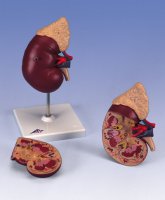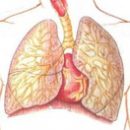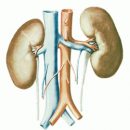Adrenal glands produce certain hormones that regulate many processes in the body. Violation of the normal operation of adrenal glands can lead to the development of severe. Pathology of adrenal glands is associated with a decrease or increase in blood hormones.
Content
The concept of adrenal diseases in children
 Each hormonal iron produces a hormonal secret (chemical compound) entering blood flow. Adrenal hormones are involved in the metabolism of substances (complex of all chemical, physical and energy processes occurring in living tissues and cells), maintain water exchange by regulating salts, adjusting hair growth on the pubic, in the axillary depressures and on the face (the so-called genital vegetation) and the functional activity of the vegetative nervous system.
Each hormonal iron produces a hormonal secret (chemical compound) entering blood flow. Adrenal hormones are involved in the metabolism of substances (complex of all chemical, physical and energy processes occurring in living tissues and cells), maintain water exchange by regulating salts, adjusting hair growth on the pubic, in the axillary depressures and on the face (the so-called genital vegetation) and the functional activity of the vegetative nervous system.
The adrenal glands are directly above the upper part of each kidney and consist of two layers: brain and cortical. Each layer produces certain hormones, the activity of which is regulated by the hypothalamus and hypophysome. The function of the adrenal glands also affects such factors such as the intake of salts, starvation, stress arising due to injuries or diseases.
The cortical layer of adrenal glands produces such hormones as cortisone, aldosterone, corticosterone, androgens. Cortisone controls the process of inflammation, stimulates the activity of enzymes in muscles, blood cells and adipose tissue, contributes to the deposition of sugar in the liver. Aldosterone regulates the growth of sex vegetation in adolescence, as well as the activity of hypothalamic-pituitary and sexual systems. Adrenaline and Noradrenalin, Celmons of the brain layer of adrenal glands, participate in the regulation of blood pressure and metabolic functions necessary to maintain a certain level of sugar content and neutral fatty acids in the blood. An excess of one of the hormones can lead to blood pressure lifting.
When impaired adrenal function, severe, life-threatening condition may develop. However, with proper and timely treatment, children with acute insufficiency of adrenal glands, as a rule, completely recover.
Violation of the function of the adrenal cortex includes two main forms:
- hypocorticism (hormone production below normal)
- hypercorticism (hormone production exceeds norm)
The most frequent forms of hypocorticism are Addison's disease and congenital lack of adrenal cortex. The most frequent form of hypercorticism is Cushing Syndrome. Of the diseases of the brain layer of adrenal glands most common is the tumor of the brain layer - feochromocytoma.
The main symptoms of adrenal insufficiency (Addison disease)
The insufficiency of the adrenal glands - pathology, which is noted during underdevelopment or impaired function of the adrenal cortex due to various diseases (such as acute blood loss, tuberculosis, autoimmune diseases - when the immune system begins to act against their own tissues of the body) and reduce hormone synthesis. Since a certain amount of hormones is still generated, symptoms may not appear until a situation occurs, which requires an increase in the secretory activity of adrenal cortex, for example, in case of concomitant diseases, injuries, stress arising due to surgical interventions.
The insufficiency of the adrenal glands is often a consequence of autoimmune diseases associated with the destruction of specific stomach cells, which leads to anemia, as well as thyroid cells, parathyroid, pancreas. For insufficiency of adrenal glands, the loss of appetite, weight and liquid, hypoglycemia (reduction of blood glucose) and seizures. Often there are diarrhea, vomiting, abdominal pain, changing skin pigmentation (golden-bronze skin), especially in skin folds, on face, neck, back, palms and joints. There may be a darkening of the skin of the genital organs, elbow, as well as many scattered dark moles or freckles. Gray or brown pigment spots can periodically appear on cheeks, gums, language.
With proper and timely treatment, all the symptoms and signs of adrenal insufficiency disappear, and the child grows and develops normally.
The main manifestations of the congenital hyperplasia of the adrenal cortex
The cause of congenital hyperplasia (excessive development) of the adrenal glands is the insufficiency of the enzymes necessary for the synthesis of the respective hormones, especially the cortisone. Since this disease is inherited by recessive type, the child so that the disease is manifested, should receive one defective genome from the father and from the mother.
In the absence of enzymes needed for hormone synthesis, cortisone is not produced in due quantity and in order to compensate for this disadvantage, the synthesis of the pituitary hormone increases, the excessive production of which causes an increase in adrenal glands in size and improved androgen products (hormones that control men's sexual activity). However, the degree of decrease in the content of enzymes does not affect the synthesis of androgen. Excessive androgens products violates normal growth and development. Approximately half of the sick children there is a violation of the synthesis of aldosterone, and they suffer from reduced synthesis of this hormone and the loss of salts leading to dehydration, paralytic expansion of blood vessels and death.
In the absence of proper treatment in children with congenital hyperplasia, adrenal delayed sexual development and underdevelopment of genital organs. Girls have masculinization, excess hair growth on the face, sometimes baldness, lack of menstruation and the development of the chest glands; excess fat deposition; low voice. In the treatment, however, children grow and develop normally. Congenital malformations of the development of external genital organs can be corrected surgically.
Cushing syndrome
Cushing Syndrome is rarely found in breast and childhood. The exceptions are cases where this disease is caused by the use of glucocorticoids, including cortisone (hydrocortisone), prednisone (prednisone), dexamethasone, for the treatment of various diseases (such as nephris orWanting asthma). In that case, if the Cushing syndrome is not a consequence of glucocorticoids, the cause of its occurrence may be a tumor of adrenal glands or pituitary. These tumors usually appear on the first day of the child's life and tend to metastasize.
For Cushing syndrome, the following symptoms and signs are characterized:
- overweight
- Slow growth
- Reduced muscle mass
- Muscular weakness
- Skin thinning
- tendency to the appearance of bruises
- reduction of glucose tolerance
These signs are a consequence of an excess of cortisone (or other synthetic glucocorticoids). There is an excessive deposition of fat on the abdomen, chest, back, shoulders, the face becomes thick and round (the so-called «Moon-shaped face»), on the abdomen, chest, lower back, hips appear red or purple stripes.
With timely surgical, drug or radiological treatment, the forecast for children with benign pituitary tumors and adrenal glands is usually favorable, for children with cancer, the forecast is less favorable, since cancer cells tend to early metastasis.
Foohomocytoma symptoms
The main disease of the adrenal cortex is a brain layer tumor (feochromocytoma). In this disease, an increase in blood pressure and the production of adrenaline and norepinephrine is noted. Excessive development of these hormones cause an increase in cardiac output, an increase in body temperature and heart rate, hyperglycemia (increase in blood sugar). The child becomes restless, nervous, excitable, he has a violated rhythm of heart abbreviations. Excess norepinephrine does not cause such effects, but slows down the heart rate. A child can develop sharp retinopathy associated with an increase in blood pressure, a disease in which the retina is damaged, the consequence of the decrease in visual acuity.
Complications of adrenal diseases
The main complication of adrenal diseases is the adrenal crisis associated with the inability of adrenal cortex to function normally and ensure sufficient production of hormones in stressful situations caused by diseases, injury or surgical interventions.
In the sudden development of severe crises and the absence of the necessary treatment, the situation becomes life-threatening (adrenal crisis can develop in bacterial meningitis).
In children with congenital hyperplasia of the adrenal cortex adrenal crises suddenly occurs in excessive loss of salts and liquids 7-11 days after birth, when the content of salts in the habitual food for the baby is low and the disease is not recognized. The child has dehydration, a sharp drop in blood pressure, due to the loss of electrolytes (main salts of the body) with urine. In the absence of medical care is a high risk of a child's heart. Similar crises may be occurring at any age if there are significantly limited quantities of drugs, water and food received by the child for several days in diseases or stressful situations.
Prevention of adrenal diseases
Since the diseases of the adrenal glands are impossible to prevent, then early treatment of newborns will help to avoid possible improper growth and development. In addition, adrenal crisis can be warned if the increased energy expenditures in children with adrenal failures during diseases, injuries, surgical interventions.
Children should constantly carry special labels with them, where the individual chart of receiving hormonal drugs is indicated. In this case, the necessary measures in the crisis situation will be accepted, even if the native child is not near.
Parents who have children with adrenal diseases, or spouses who plan to be the birth of a child, but in the family of adrenal disease, should consult with genetics.









